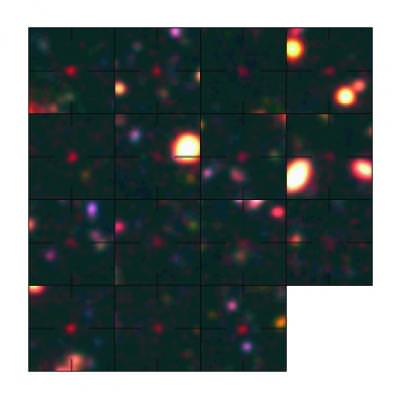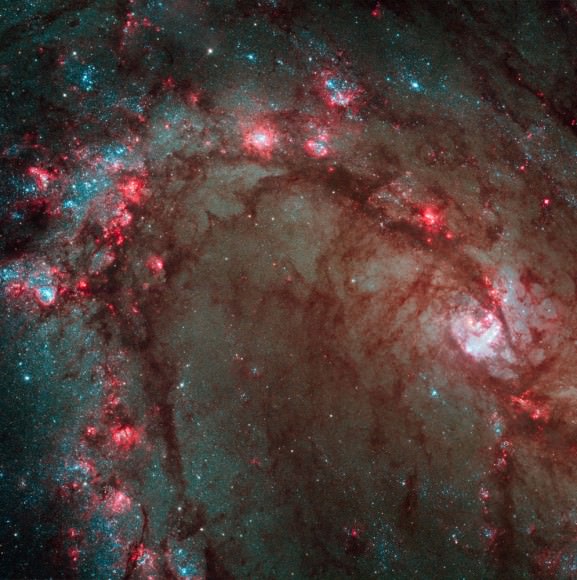Good News for Science News

Here's some refreshing news! In an era when mainstream media is cutting back on their science departments and science reporting, the Discovery Channel has just made an investment to step-up their science news with the re-launch of their new and improved news website, Discovery News. In the middle of it all is our very own Ian O'Neill, who is also the producer for Discovery News Space. The "new" part of Discovery News is that Ian's work on the space side is now integrated into a higher profile, redesigned news site. Ian and I had a chance to talk today about this good news for science news.
(...)
Read the rest of Good News for Science News (255 words)
NASA Science News for November 10, 2009
The 2009 Leonid meteor shower peaks on Nov. 17th with a sprinkling of meteors over North America and a possible outburst over Asia.
FULL STORY at
http://science.nasa.gov/headlines/y2009/10nov_leonids2009.htm?list1035898
Physicist Vitaly Ginzburg Dies at age 93
 Vitaly Ginzburg, a Russian physicist and Nobel laureate, died yesterday of cardiac arrest. He was 93 years old. Ginzburg shared the 2003 Nobel Prize in physics for his work on superconductors, but contributed to many other fields of study, including quantum theory, astrophysics, radio-astronomy and diffusion of cosmic radiation in the Earth's atmosphere. In addition, he is known for his contributions to the development of the Russian hydrogen bomb in the 1950s, for which he received the Stalin Prize.(...)
Vitaly Ginzburg, a Russian physicist and Nobel laureate, died yesterday of cardiac arrest. He was 93 years old. Ginzburg shared the 2003 Nobel Prize in physics for his work on superconductors, but contributed to many other fields of study, including quantum theory, astrophysics, radio-astronomy and diffusion of cosmic radiation in the Earth's atmosphere. In addition, he is known for his contributions to the development of the Russian hydrogen bomb in the 1950s, for which he received the Stalin Prize.(...)
Read the rest of Physicist Vitaly Ginzburg Dies at age 93 (316 words)
Planetary Society to Launch Three Separate Solar Sails
On the 75th anniversary of astronomer Carl Sagan's birth, the Planetary Society announced their plans to sail a spacecraft on sunlight alone by the end of 2010. Called LightSail, the project will launch three separate spacecraft over the course of several years, beginning with LightSail-1, which will demonstrate that sunlight alone can propel a spacecraft in Earth orbit. LightSails 2 and 3, will travel farther into space.
Sagan, co-founder of the Planetary Society was a long-time advocate of solar sailing.
(...)
Read the rest of Planetary Society to Launch Three Separate Solar Sails (463 words)
Surprise! Unknown Asteroid Buzzed Earth

A previously undiscovered asteroid came within 14,000 km of Earth last week, and astronomers noticed it only 15 hours before closest approach. On Nov. 6 at around 16:30 EST a 7 meter asteroid, now called 2009 VA, came only about 2 Earth radii from impacting our home planet. This is the third-closest known non-impacting Earth approach on record for a cataloged asteroid.
(...)
Read the rest of Surprise! Unknown Asteroid Buzzed Earth (181 words)
NASA Satellites Monitor Tropical Storm Ida

NASA has been keeping an eye on tropical storm Ida off the Gulf Coast, which was downgraded from a hurricane earlier today. Its satellites have been helping meteorologists to measure the rainfall and windspeeds of the storm. Ida is predicted by the National Hurricane Center in Miami, Florida to make landfall near Pensacola, Florida on Tuesday morning (Nov. 10th), after which it is expected to drop in intensity and head East.(...)
Read the rest of NASA Satellites Monitor Tropical Storm Ida (311 words)
One Strange Mars Rock

Opportunity has come upon another big rock on Mars. But what is it? Another meteorite? A big clump of ejecta from an old impact? There's lots of other debris scattered around this area as well. The rock has been named "Marquette Island," staying with the island theme for the other meteorites Oppy has come across, and the rover may take the "opportunity" to get closer to this rock and check it out, given the sand dunes surrounding it don't provide too much of an obstacle. So maybe next week we'll find out what it is. But in the meantime, enjoy these color and 3-D images (see more below) of the rock via Stu Atkinson from Unmannedspaceflight.com. Check out more great looks at Marquette Island at Stu's blog about Oppy's travels, Road to Endeavour.
Oh, and rumor has it that the extrication process may have begun to free the Spirit rover. Latest images show she has moved every so slightly. More as it becomes available….
(...)
Read the rest of One Strange Mars Rock (29 words)
Bread Dropped By Bird Causes Problems for LHC

Yes, this headline appears to be true. A bird dropping a piece of bread onto outdoor machinery has been blamed for a technical fault at the Large Hadron Collider (LHC) this week which saw significant overheating on parts of the accelerator. The LHC was not operational at the time of the incident, but the spike produced so much heat that had the beam been on, automatic safety detectors would have shut down the machine. This would put the LHC out of action for a few days while it was restarted, but there would be no repeat of the catastrophic damage suffered last September. That's when an electrical connection in the circuit itself failed violently, causing a massive liquid-helium leak and subsequent damage along hundreds of meters of magnets.
Hmm. The idea of a time-traveling Higgs boson coming back to prevent its own discovery is seeming less and less far fetched!
(...)
Read the rest of Bread Dropped By Bird Causes Problems for LHC (94 words)
Space Junk May Force Crew from ISS

Update #2, 5:30 pm: NASA has now said that after further analysis, the space debris they have been tracking no longer poses any concern or threat to the ISS. Everyone can rest easy tonight! The piece of debris was only 5 cm long, and will not pass within the "pizza box" zone around the station (0.75 x 25 x 25 kilometers) that calls for an alert.
A hard-to-track piece of space junk may come within a half a kilometer of the International Space Station later today, and NASA managers are considering asking the crew to board the docked Soyuz capsules as a precaution. The time of closest approach is at 10:48 p.m. EST, and the object was detected too late for the station to do an evasive maneuver. Depending on the outcome of additional tracking data analysis, the crew may be awakened later and directed to go into the Soyuz vehicles around 10:30 pm or given the option to sleep in Soyuz tonight. NASA says they don't believe the crew is at risk, but precautions are prudent in dealing with space debris.
(...)
Read the rest of Space Junk May Force Crew from ISS (188 words)
Early Galaxy Pinpoints Reionization Era

Astronomers looking to pinpoint when the reionozation of the Universe took place have found some of the earliest galaxies about 800 million years after the Big Bang. 22 early galaxies were found using a method that looks for far-away redshifting sources that disappear or "drop-out" at a specific wavelength. The age of one galaxy was confirmed by a characteristic neutral hydrogen signature at 787 million years after the Big Bang. The finding is the first age-confirmation of a so-called dropout galaxy at that distant time and pinpoints when the reionization epoch likely began.
(...)
Read the rest of Early Galaxy Pinpoints Reionization Era (532 words)
NASA Science News for November 6, 2009
Long ago, something calamitous happened to Mars, transforming a warm and hospitable world into the frigid, seemingly lifeless desert we see today. Many scientists believe the Red Planet lost most of its atmosphere, but how? A new NASA mission named MAVEN is specifically designed to answer that question.
FULL STORY at
http://science.nasa.gov/headlines/y2009/06nov_maven.htm?list1035898
Hubble Unveils Stunning Star Birth in M83

It appears Hubble's new Wide Field Camera 3 (WFC3) is working. And how! The new camera installed during Servicing Mission 4 in May has delivered the most detailed view of star birth in the graceful, curving arms of the nearby spiral galaxy M83. Nicknamed the Southern Pinwheel, M83 is undergoing more rapid star formation than our own Milky Way galaxy, especially in its nucleus. The sharp "eye" of WFC3 has captured hundreds of young star clusters, ancient swarms of globular star clusters, and hundreds of thousands of individual stars, mostly blue supergiants and red supergiants.
(...)
Read the rest of Hubble Unveils Stunning Star Birth in M83 (131 words)
Found: Theoretical Supernova Actually Exists
Astronomers have identified a type of supernova that appears to be a type predicted in theory but never actually observed before. Two years ago Lars Bildsten from UC Santa Barbara and his colleagues predicted a new type of supernova in distant galaxies which they dubbed the “.Ia” (point one a) mechanism, involving a helium detonation on a white dwarf, ejecting a small envelope of material. This theoretical explosion would be fainter than most other supernovae and its brightness would rise and fall in only a few weeks. Dovi Poznanski from Berkeley went back and looked at seven-year-old observations and found this unusual kind of supernova. Poznanski and colleagues say supernova 2002bj belongs in its own category, as its spectra suggest that it evolved extremely fast and produced an unusual combination of elements.
(...)
Read the rest of Found: Theoretical Supernova Actually Exists (474 words)
Multi-Planet System is Chaotic, Dusty

NASA's Spitzer Space Telescope captured this infrared image of a giant halo of very fine dust around the young star HR 8799. Image credit: NASA/JPL-Caltech/Univ. of Ariz.
Just what is going on over at the star HR 8799? The place is a mess! But we can just blame it on the kids. Young, hyperactive planets circling the star are thought to be disturbing smaller comet-like bodies, causing them to collide and kick up a huge halo of dust. HR 8799 was in the news in November 2008, for being one of the first with imaged planets. Now, NASA's Spitzer Space Telescope has taken a closer look at this planetary system and found it to be a very active, chaotic and dusty system. Ah, youth: our solar system was likely in a similar mess before our planets found their way to the stable orbits they circle in today.
Neutron Star at Core of Cas A Has Carbon Atmosphere

A Chandra X-ray Observatory image of the supernova remnant Cassiopeia A. Credit: NASA/CXC
Supernova remnant Cassiopeia A (Cas A) has always been an enigma. While the explosion that created this supernova was obviously a powerful event, the visual brightness of the outburst that occurred over 300 years ago was much less than a normal supernova, — and in fact, was overlooked in the 1600's — and astronomers don't know why. Another mystery is whether the explosion that produced Cas A left behind a neutron star, black hole, or nothing at all. But in 1999, astronomers discovered an unknown bright object at the core of Cas A. Now, new observations with the Chandra X-Ray Observatory show this object is a neutron star. But the enigmas don't end there: this neutron star has a carbon atmosphere. This is the first time this type of atmosphere has been detected around such a small, dense object.
(...)

